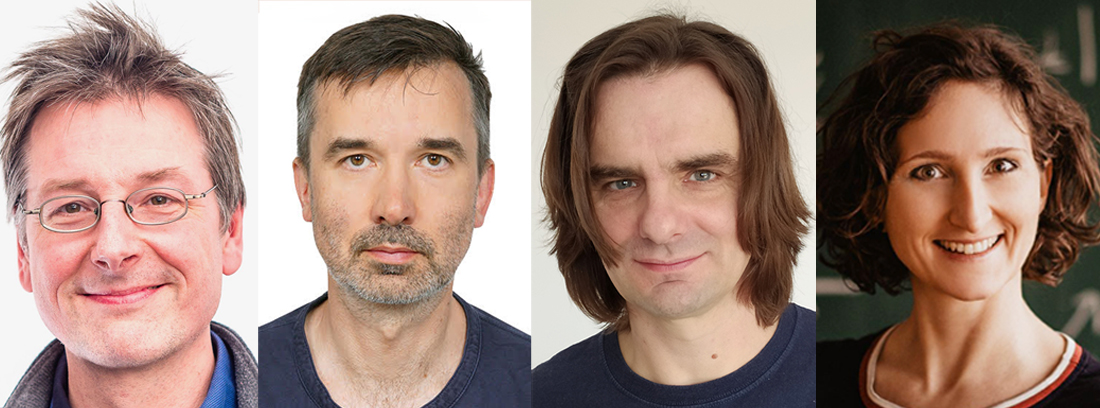International PhD course
“Topics in Geometric Group Theory”

Courses:
“Isomorphism Conjectures” by Arthur Bartels (University of Münster)
“Kazhdan’s property (T)” by Piotr W. Nowak (Polish Academy of Sciences)
“Helly graphs and groups” by Damian Osajda (University of Copenhagen)
“Buildings” by Petra Schwer (Otto-von-Guericke-University Magdeburg)
The course is evaluated at 5 ECTS. It will start Monday morning and end Friday around 2pm.
Venue:
Department of Mathematical Sciences
Universitetspark 5
2100 Copenhagen Ø Denmark
We cannot offer any financial support for participants (except free lunches, coffee breaks, and a reception). Flights/trains and lodging have to be organized on your own. Here are some practical info:
https://www.math.ku.dk/english/contact/find-us/
Schedule and Course Materials
Descriptions:
“Isomorphism Conjectures”
Motivated by surgery theory Farrell and Jones used the dynamic of the geodesic flow on non-positively curved manifolds for computations in K-theory. Their results led them to a conjectural picture of the K-theory of group rings, now known as the Farrell-Jones Conjecture. The dynamical argument proved to be very versatile and has been applied in many non-positively curved settings including (relatively) hyperbolic groups, CAT(0)-groups and Mapping class groups. Recently it has also been used in connection with smooth representation theory of p-adic reductive groups. The lectures will give an introduction to these results and explain how geometric properties of groups are exploited. Time permitting we will contrast the Farrell—Jones Conjecture with its counterpart in topological K-theory, the Baum—Connes Conjecture. Formally the two conjectures are very similar, but the results are quite different.
“Kazhdan’s property (T)”
Kazhdan's property (T) has been introduced by David Kazhdan in 1967 as a tool for proving an important result about finite generation of lattices in Lie groups. Since then the property has been studied thoroughly in the frame of operator algebras and in the mainstream of geometric group theory. For discrete groups Kazhdan's property (T) is equivalent to the non-existence of fixed-point-free actions on Hilbert spaces. It has been proven for number of (classical families of) groups, but there are still many open questions left.
The course will focus on basics on Kazhdan’s property (T) and on presenting recent advancements to proving the property for various groups, including the outer automorphisms group.
“Helly graphs and groups”
Helly graphs are classical objects within metric and algorithmic graph theory. A graph is Helly if any family of pairwise intersecting balls has a nonempty intersection. In recent years Helly graphs, and closely related injective metric spaces has been intensively studied within the geometric group theory. It has been shown that many (classical) groups act nicely on Helly graphs and/or injective metric spaces, leading to better understanding of such groups.
The course will be focused at presenting the basics on Helly graphs, injective metric spaces, their automorphism groups, and on recent applications of the objects within geometric group theory.
“Buildings”
Introduced by Tits and Bruhat Tits buildings were constructed to serve as an analogon to symmetric spaces in the case of reductive groups over non-archimedian local fields, potentially with a discrete valuation. Many algebraic properties of those groups and their subgroups are encoded by the geometry of the buildings. In the meantime the theory of buildings has gown and nowadays touches many areas of modern mathematics.
In this mini-course we will introduce buildings from a point of view of geometric group theory. We will provide concrete examples, will get to know some of their geometric features - such as retractions, the CAT(0) property and thelike - and discuss some properties of groups acting on them. Moreover, we aim to explain how the geometry of retractions and the combinatorics of folded galleries provides a unified framework to study orbits in affine flag varieties.
This course will start elementary in order to serve as a basic and introductory course of interest to students with various backgrounds.
Registration:
For registration, send an email to Martín Blufstein (mabc@math.ku.dk) ) with the following info:
- Name
- Affiliation
- Position (MSc student/PhD student/post-doc/etc.)
- Dates of arrival/departure
